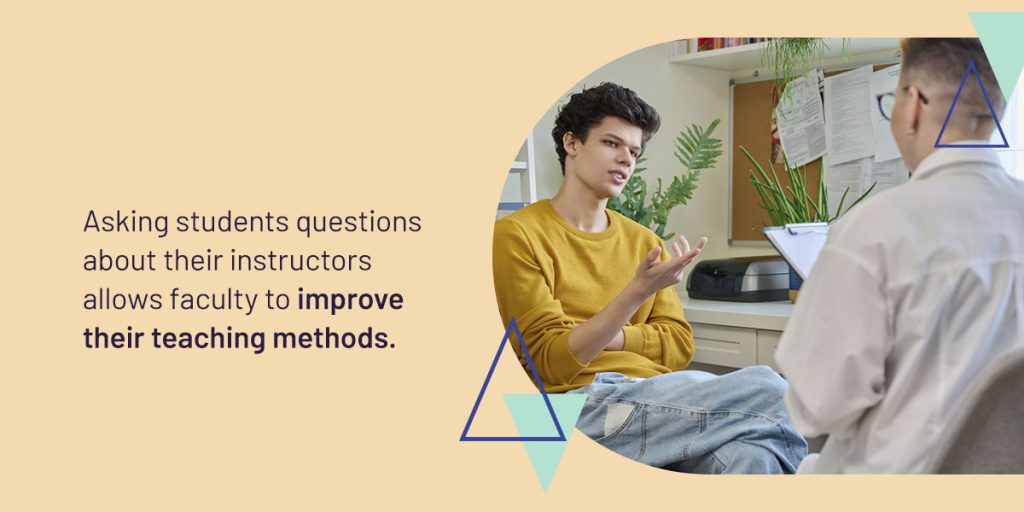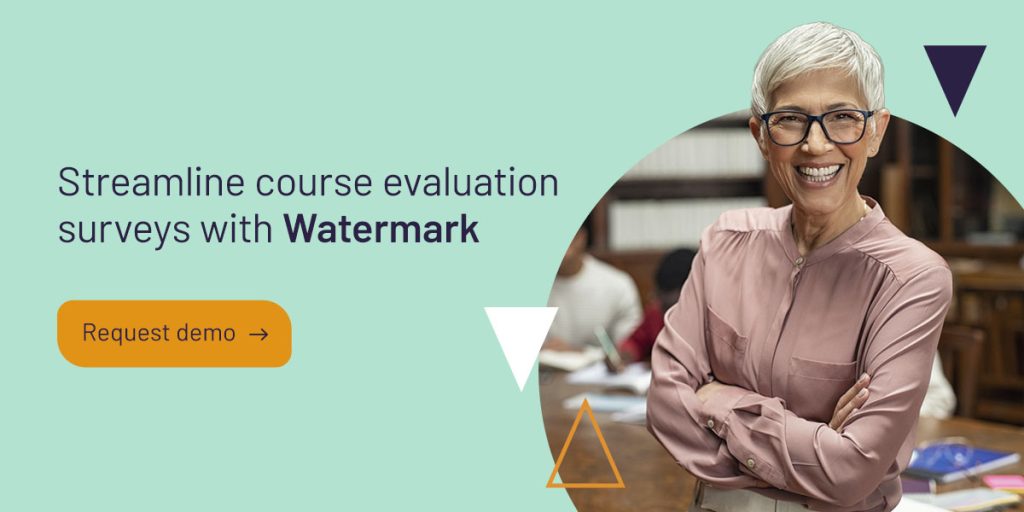




Course evaluation surveys areone of the simplest ways your institution can improve student retention and performance. They allow you to gather insightful student feedback about course content and teaching methods. Using this information, you can better understand the student experience and make more impactful decisions to improve it.
However, course evaluations are only as useful as the questions within them. Before creating your institution’s evaluation surveys, read over the examples in this guide. We’ve also included advice on survey timing, customization, and question types to help you create effective, actionable course evaluation surveys.
Question quality can make or break your survey results. But what exactly does a good question look like?
Questions are usually better when they are specific, concise, and easy to understand. They also follow a logical order to make it easier for respondents to answer. Spending extra time to ensure your survey contains high-quality questions is worthwhile as it can result in:
If you need some inspiration for your institution’s course evaluation surveys, read through the examples below. We’ve included some general questions and more specific ones related to teaching, course content, and self-evaluation. Include about 15 questions in your survey so it’s quick to complete, and focus on only asking questions about things you need feedback on the most.
General questions can apply to courses in any field or area of study and provide insight into how useful and relevant students feel the courses are. Here are some examples of general course survey evaluation questions:

Asking students questions about their instructors allows faculty to improve their teaching methods. Feedback about teaching quality is also an essential metric to include in faculty performance reviews. Here are some sample questions related to the instructor and their performance:
In addition to questions regarding the professor, course evaluation surveys should include inquiries about the course. However effective an instructor might be, course material, design, and structure are just as important. Course-related prompts for evaluation might include:
Consider including course evaluation questions for students to measure their commitment to the course, too. These responses can help you determine the credibility of the survey-taker and how much value to place on their response. For example, feedback from a student who regularly attends class may be more valuable for assessing teaching effectiveness than from a student who rarely attends class.
Here are a few questions to ask regarding student self-evaluation:
If one or more teaching assistants (TAs) aid with instruction, grading, or other tasks, it’s necessary to ask some evaluation questions about them. Answers to these questions help institutions determine how well their TA programs work for students. The data could also help professors choose the best TAs for their courses.
Examples of teaching assistant-related questions include:
Courses in different departments have different objectives, methods, and purposes. For example, the teaching methods and content in an art course will differ significantly from those in a science course. That’s why it’s beneficial for courses in separate departments to have different course evaluation questions. You can tailor questions around the course material, structure, and teaching methods to make it more relevant.
With that said, course evaluation questionnaires should have some similarities across departments. Whether a course revolves around creating pottery or understanding biological chemistry, all courses in higher education have a few objectives in common. In all courses, instructors need to present information clearly, help students understand course material, and return assignments with helpful feedback. In addition, all courses should follow their syllabi, have an organized flow, and include relevant content and assignments.
General questions about instructors, courses, students, and TAs will give your institution the tools to measure basic standards across departments. When designing course evaluation surveys, it’s a good idea to include both general and department-specific questions.
Your institution’s course evaluation surveys can all follow a similar format and include common questions, but you should add course-specific questions to gather more relevant feedback. Here are examples of questions you can ask for art, science, and business courses to give you an idea of how to customize them:
Courses in the arts help students improve specific artistic skill sets and allow them to create original work. Here are some of the questions you might ask students following an arts course:
Courses in the sciences are unique for several reasons, and their surveys should reflect that. Science courses often involve labs, out-of-classroom experiences, and report writing. Some questionsthat are relevant to science courses can include:
Business courses have objectives unique from arts and science courses. These courses help build an understanding of financial, legal, ethical, operational, and administrative business-related concerns. Their course evaluation questions might include the following:
Another important factor to consider when conducting course evaluation surveys is timing. While end-of-course survey questions are useful, you might also want to establish mid-course evaluation questions. These questions will help you gauge how students respond to a course while in the midst of assignments and instruction, as they may feel differently from the middle to the end of the course.
Mid-course survey evaluation questions can include:
Surveys should include multiple question types to limit survey fatigue and offer a range of feedback. The two main questions types to consider include:
Good course survey evaluation questions may sometimes not be questions at all. You might phrase them as statements with an accompanying Likert scale to show how much a student agrees with the statement. An example of a Likert scale question might be, “I enjoyed this course and the material I learned in it.” The student can answer by choosing one option from the following:
The Likert scale is helpful because it shows the intensity of the survey-taker’s feelings regarding the subject. Regardless of how many points are on the scale, symmetry is important — neutrality should be the centermost option. Other examples of close-ended questions include yes or no questions and multiple choice.
Your surveys should also give students a chance to answer some open-ended questions. These questions allow students to elaborate on their answers or express concerns not addressed in other questions. Some sample open-ended questions might include:






























































































































































































































































































































































































